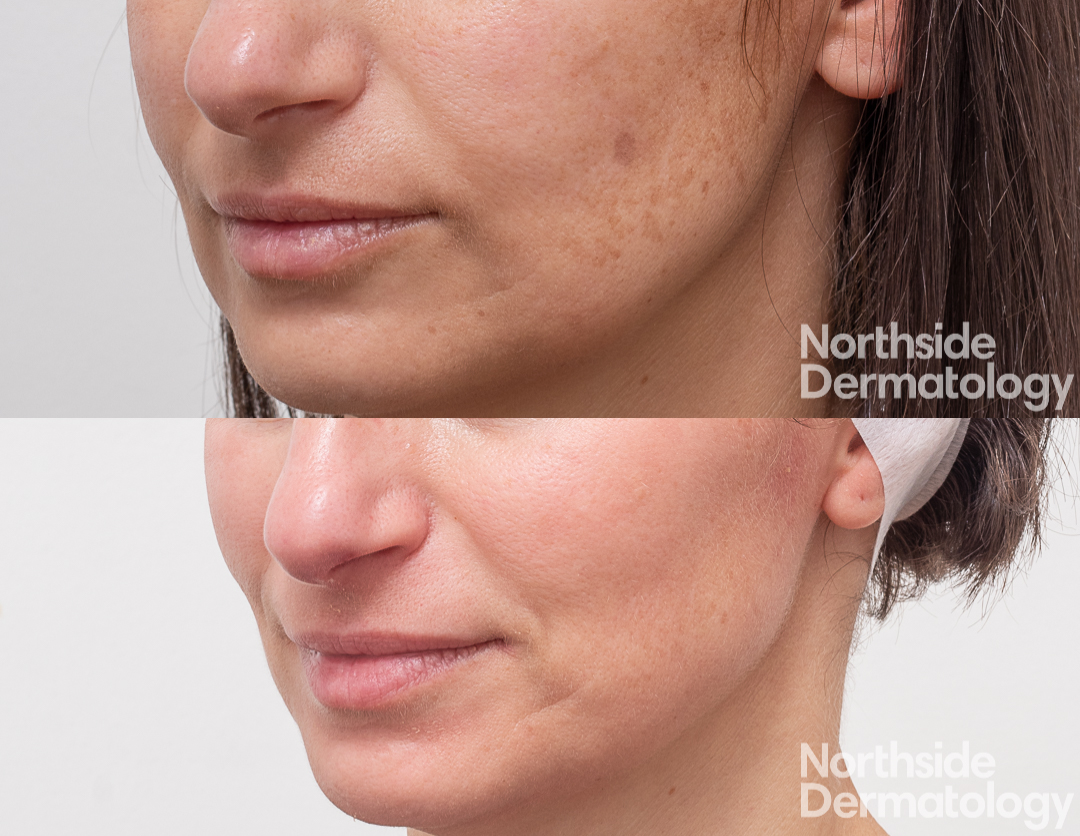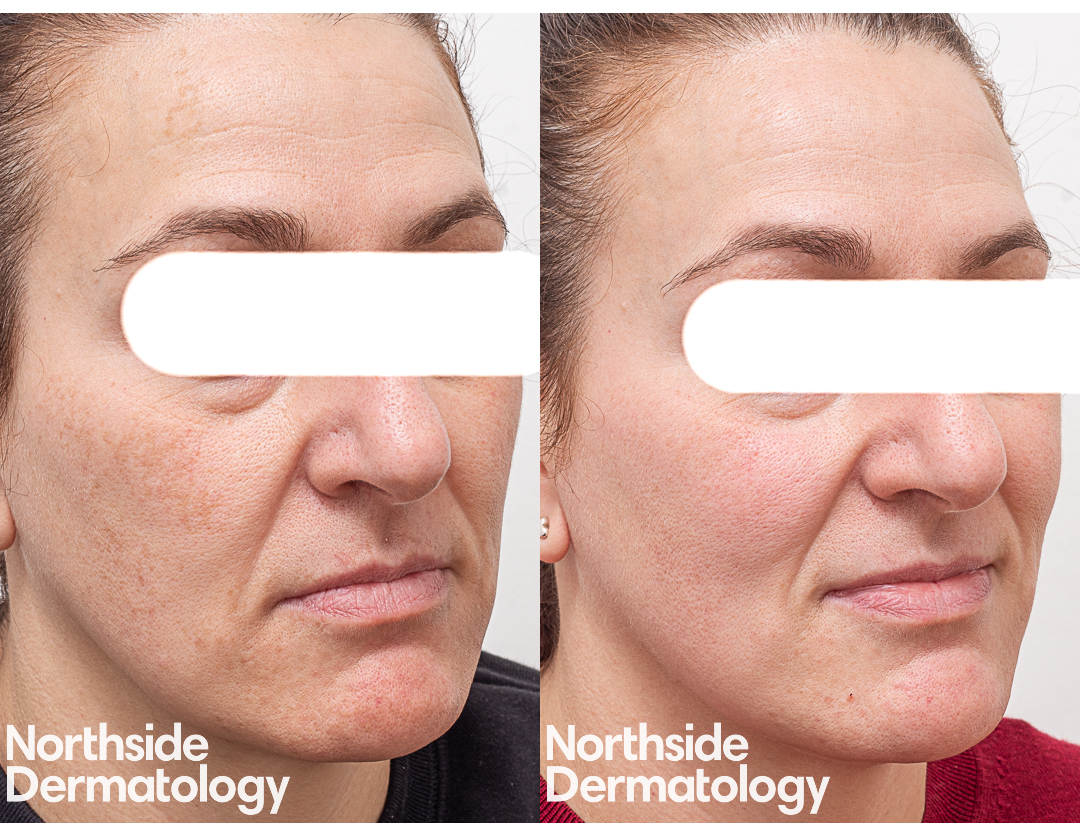
Specialist Melasma Treatment
There are many causes of unwanted skin pigmentation. One of the most well-known pigmentation concerns is melasma, a condition in which patients develop patchy areas of darkness on the face and sometimes on nearby areas of the body. Melasma is best treated with a medical approach under the guidance of a specialist dermatologist.
Before & After Photos
Before and After photos following one treatment with custom peel.

Actual patient of Northside Dermatology. Photos are taken with our standardised clinical photography system and published with patient’s consent. Individual results may vary. A thorough consultation is required prior.
Combination treatment with prescription medication and Q switched laser for melasma (B and A photos)

What Is Melasma?
Melasma appears as patches of brown pigmentation on areas that are chronically exposed to the sun. It most often arises on the face, typically on the forehead, cheeks, nose, upper lip and chin. Melasma can also affect the arms and the back. Women are more likely to develop melasma than men. Those who tan well or naturally have a darker skin tone are also more prone to developing melasma. Though the condition does not affect an individual’s health, melasma can be a source of embarrassment or anxiety about one’s appearance.
What Causes Melasma?
The cause of melasma is unknown, but several contributing factors have been identified. The darkening of the skin is due to overproduction of pigment (melanin) by pigment-producing cells (melanocytes). This can be a result of a genetic predisposition and/or a trigger, such as:
- Sun exposure
- Hormonal changes, often due to pregnancy or use of oral contraceptive pills
- Certain medications, cosmetics, skincare products and toiletries
What Are the Different Types of Melasma?
Melasma is categorised into three primary types:
- Epidermal: Epidermal melasma is characterised by the presence of excess melanin in the outermost layers (epidermis) of the skin. The pigmentation is brown with well-defined borders. Epidermal melasma is typically more responsive to treatment.
- Dermal: Dermal melasma is identified by the presence of cells that ingest melanin, called melanophages, in the middle layer (dermis) of the skin. The pigmentation is brown, blue or grey with poorly defined borders. Dermal melasma is harder to treat.
- Mixed: Mixed melasma includes both the epidermal and the dermal type. The pigmentation is brown-grey in colour. Treating mixed melasma can be difficult but some improvement can be achieved.
A dermatologist may use a specialised light called a Wood’s lamp to determine the location of the pigment and the type of melasma.
How Is Melasma Diagnosed?
A dermatologist diagnoses melasma after examining the colour and pattern of the pigmentation. In some cases, a biopsy is necessary to confirm the diagnosis and exclude other possible causes of increased pigmentation. Pigmentation that involves a more extensive area of the body may require additional assessment, as it can be an indication of another pigmentary disorder or an underlying medical condition.
How Can I Manage Melasma At Home?
Melasma is a recurrent condition that requires ongoing maintenance therapy. To manage the condition at home, the dermatologists who consult at Northside Dermatology recommend:
- Daily use of sun protection with SPF50+ formulated with both a chemical blocker and a physical blocker (zinc oxide and iron oxide) that protect from UVA and UVB rays. This is the most simple and effective step in the treatment and prevention of melasma. A MUST for all.
- Applying sunscreen daily all year round, regardless of how much sun you are going to be exposed to and the time of year. Reapply sunscreen if you are sweating or are exposed to water.
- Wearing broad-brimmed hats and seeking shade while outdoors
- Applying foundation over the sunscreen provides an additional level of visible light protection.
- Individuals with darker skin can avoid the white cast associated with physical blockers by choosing a sunscreen with a micro-ionised formula that blends into the skin.
- Using makeup to camouflage the irregular pigmentation
- Discontinuing the use of oral contraceptives or hormone-releasing intrauterine devices if hormonal factors are implicated.
What Medical Treatment Is Available For Melasma?
Melasma is a challenging condition to treat. The optimal treatment approach will depend on the type of melasma you have and your skin type. Often, a combination of treatments are required, rotating through topical/injection/oral medications, chemical peels and laser treatment.
Topical treatments for melasma include:
- Hydroquinone: This is the most widely used method to treat melasma. Hydroquinone cream is available in a stand-alone formulation or mixed with other active ingredients. It should only be used for limited periods under the supervision of a dermatologist.
- Vitamin A: Prescription vitamin A cream is available as a stand-alone treatment or in combination with other agents. As it can cause skin irritation, its use should be closely monitored by a dermatologist.
- Vitamin C: Vitamin C is sometimes used in combination with other treatments, such as hydroquinone.
- Methimazole: Methimazole cream is used to treat hyperthyroidism. It may reduce melanin production and pigmentation in hydroquinone-resistant melasma.
- Azelaic Acid: Azelaic acid (20%) applied twice daily as a cream, lotion or gel can improve cases of superficial melasma.
- Tranexamic Acid: Tranexamic acid as a cream has shown promise as a treatment for melasma. However, it may cause irritation and its penetration into the skin can be variable.
Other treatments for melasma include:
- Oral Medication: Oral tranexamic acid is available as a tablet for melasma that has not responded to topical treatment.
- Laser Treatments: Laser treatments are used as part of combination treatment. They are particularly useful as part of rotational treatment, when the medical treatments of melasma are ineffective or when the effects plateau. Lasers used to treat melasma include:
- 755nm picosecond laser (Picosure Pro) can be used to treat superficial or mixed melasma. This is the only FDA approved picosecond laser for melasma. The laser provide photomechanical energy to shatter the pigment.
- 1064nm Q-Switched Nd:YAG Laser: Treatment must be conducted at low power settings and a number of sessions are required to see improvements. Suitable for deeper melasma
- 1927nm fractional thulium laser: This fractional laser at low energy setting can be used either as a stand alone treatment or in combination with topical tranexamic acid (laser assisted drug delivery)
- Vascular Laser: Recent studies show that the excessive pigmentation of melasma can result in part from blood vessel abnormalities. Vascular laser treatment can be effective in treating this subtype of melasma.
- Chemical Peels: Chemical peels have some success in treating melasma. Superficial peels are preferable, including glycolic acid peels, lactic acid peels, low-strength trichloroacetic acid peels and retinoid peels. Multiple treatments are required to achieve modest improvements. Chemical peels are best used in conjunction with topical creams. Proprietary peels such as Cosmelan is sometimes used to treat, but the rebound rate if high and it has to be done in combination with other medical treatment.
- Microneedling: Microneedling is often promoted as a treatment. The dermatologists who consult at Northside Dermatology do NOT recommend this as it can worsen the condition
What Is the Outlook for Melasma?
Melasma may fade on its own. This is most likely to happen when a trigger causing the melasma, such as a pregnancy or oral contraceptive, is no longer present. In other cases, melasma can last a lifetime. If treatment is undertaken, melasma is generally slow to respond and the results are often limited to partial improvements. Epidermal melasma has a better prognosis than dermal or mixed melasma. All types can return and require continuing treatment to be managed successfully.
Though it can be stubborn, many people with melasma have a good outcome under a dermatologist’s care. Call Northside Dermatology on 03 8582 8688 to book a consultation.
Contact Us
Hours of Operation
Monday - Friday, 9am-5pm
Phone Number
Fax Number
Emails
Medical Enquiries:
reception@northsidedermatology.com.auLaser & Cosmetic Enquiries:
cosmetic@northsidedermatology.com.au